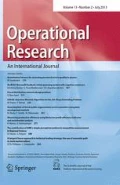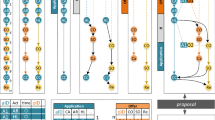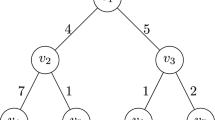Abstract
Various methods for identifying the critical path in linear schedules have been proposed over the last years. Work done in comparing these methods has shown that in many activity configurations, their results do not coincide. This paper attempts a critical path comparison between the linear scheduling method KLRPM, developed by the authors, and the network scheduling method CPM. In order to achieve this comparison, a correspondence between activity relationships of the CPM and the KLRPM is established first. The results of the two methods are then tested for some simple activity configurations and applied on an illustrative example taken from the literature. The results are commented and recommendations for further research are proposed.
Similar content being viewed by others
References
Al Sarraj, Z. (1990). “Formal development of line-of-balance technique”.Journal of Construction Engineering and Management, ASCE, vol. 116 (4), 689–704.
Arditi, D. and Abdulak, M. (1986). “Line-of-balance scheduling in pavement construction”.Journal of Construction Engineering and Management, ASCE, vol. 112 (4), 411–424.
Birrell, G. S. (1980). “Construction Planning—Beyond the critical path”.Journal of Construction Division, ASCE, vol. 106 (3), 389–407.
Chrzanowski, E. N. and Johnston, D. W. (1986). “Application of linear scheduling”.Journal of Construction Engineering and Management, ASCE, vol. 112 (4), 476–491.
Harris R. B. and Ioannou, P. G. (1998). “Scheduling Projects with Repeating Activities”.Journal of Construction Engineering and Management, ASCE, vol. 124 (4), 269–278.
Harmelink, D. J. and Rowings, E. J. (1998). “Linear Scheduling Model: Development of Controlling Activity Path”.Journal of Construction Engineering and Management, ASCE, vol. 124 (4), 263–269.
Johnston D. W. (1981). “Linear Scheduling Method for Highway Construction” Journal of Construction Division, ASCE, 107 (2), 247–261.
Kallantzis, A. and Lambropoulos, S. (2004A). “Critical Path determination by incorporation of Minimum and Maximum Time and Space Constraints into Linear Scheduling”.Engineering Construction and Architectural Management, Emerald, vol. 11 (3), 211–222.
Kallantzis, A. and Lambropoulos, S. (2004B). ”Discussion of ‘Comparison of Linear Scheduling Model and Repetitive Scheduling Model”.Journal of Construction Engineering and Management, ASCE, vol. 130(3), 463–467.
Kallantzis, A. and Lambropoulos, S. (2003). “Evaluation of critical path methods for linear projects”.In Ahmed, S., Ahmad, I., S.L and Azhar,. S. (eds) Proceedings of the 2 nd International Conference on Construction in the 21 st Century “Sustainability and Innovation in Management and technology”, December 10–12, Hong Kong, pp. 426–431 [ISBN 988-97370-1-9]
Mattilla, K. G. and Park, A. (2003). “Comparison of Linear Scheduling Model and Repetitive Scheduling Method”.Journal of Construction Engineering and Management, ASCE, vol. 129 (1), 56–64.
Reda, R. M. (1990). “Repetitive Project Modelling”.Journal of Construction Division, ASCE, vol. 116 (2), 316–330.
Russell, A. D. and Wong, W. C. (1993). “New generation of planning structures”.Journal of Construction Engineering and Management, ASCE, vol. 119(2), 196–214.
Selinger, S. (1980). “Construction planning for linear projects”.Journal of Construction Division, ASCE, vol. 106 (2), 195–205.
Stradal, O. and Cacha, J. (1982). “Time Space Scheduling Model”.Journal of Construction Division, ASCE, vol. 108 (3), 445–457.
Author information
Authors and Affiliations
Rights and permissions
About this article
Cite this article
Kallantzis, A., Lambropoulos, S. Correspondence of activity relationships and critical path between time-location diagrams and CPM. Oper Res Int J 4, 277–290 (2004). https://doi.org/10.1007/BF02944146
Issue Date:
DOI: https://doi.org/10.1007/BF02944146




